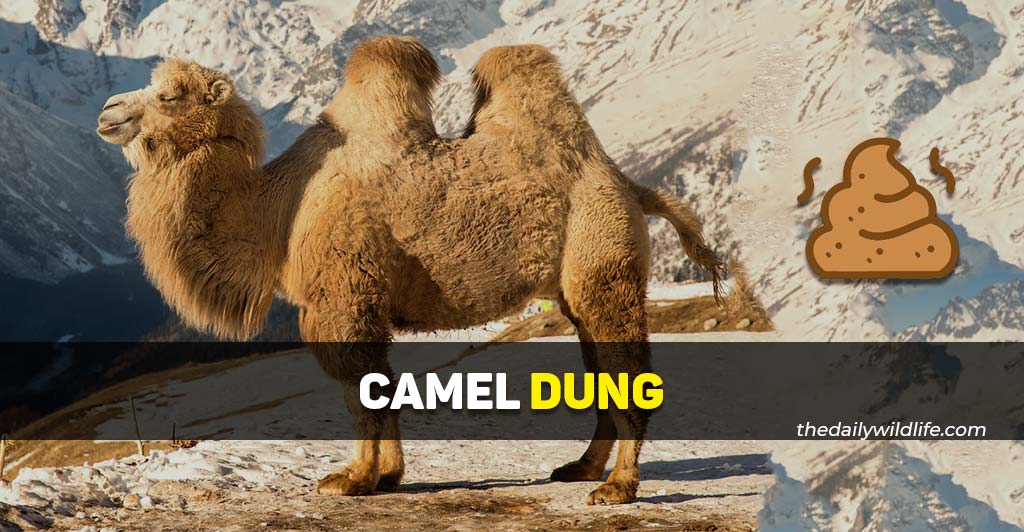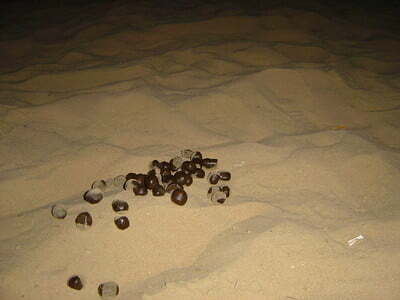The first recorded use of animal manure was in Egypt at around 3000 BC where they used it as a fertilizer on their fields. [1]
Greeks and Romans were the ones to follow and used it to improve their harvests and to produce summer vegetables during winter.
Manures have been used since the dawn of civilization until the rise of chemical fertilizers in the 1940s.
And similar to almost all animals, camels do poop. They will excrete waste from their bodies in a form of dung.
In this article, we will look deeper into the use of camel dung, how it looks, and its flammability characteristics.

Table of Contents
What Is Camel Dung?
Camel dung (or camel manure) is a solid by-product of a camel’s body that can be used as a valuable source of nutrients for crops and grasslands. It mostly consists of the animal’s feces.
Simply said, camel dung is a tidy word for an untidy matter – camel poop.
Farmers will usually say camel manure when they talk about the animal’s dung.
What Does Camel Dung Look Like?
Camel’s dung looks like dry, neat, and round balls. In a healthy camel, these balls of poop will be as round as chestnuts or apples. It can have a dark yellow or brown color.

image by Daniel Kwok via Flickr | CC BY 2.0
If a camel is not properly hydrated, these dung pellets shrink and are smaller in size.
Why Is Camel Dung Hard And Dry?
In order to conserve water, camels will excrete dung that is extremely hard and dry. Their intestines will reabsorb as much water from the food that is being digested as possible, resulting in dry feces.
A camel is a Xerocole.
Xerocole are animals that live in arid desert environments and produce concentrated excretion (i.e. urine and feces) to conserve water.
Temperatures during the day in deserts can reach an average of 100 degrees F (38 degrees C).
And as there is basically no water to be found for miles, camels had to adapt their bodies to lose as little water as possible from their bodies.
Their light fur can reflect sun rays, their thick wooly fur prevents heat from reaching the skin and making the animal sweat less, their special nostrils and long nasal passages reduce water loss through breathing, and their kidneys produce highly concentrated urine that is very thick and salty.
Preventing water loss via their feces is the next logical thing to do.
A camel’s three-chambered stomach allows the animal to take as most nutrients and water as possible from the plant before excreting it.
Camel Dung Uses
Throughout history, camel dung was used as an organic fertilizer, fuel, and probiotic for the treatment of dysentery. Because of its fiber-rich content, camel dung can be used for the decomposition of organic compounds spilled within the soil/water and can also combat desertification and fix sand dunes.
1. Camel Dung As Organic Fertilizer
Camel manure can be used as an organic fertilizer as it was shown that it is a good source of carbon, nitrogen, ammonia, and other valuable nutrients required for agricultural crops to grow.
Compared to a cow, a goat, and a buffalo, the camel has the least carbon (C) in its manure.[2]
The order goes (from low to high): camel – buffalo – goat – cow.
Higher concentrations of carbon make plants more productive as it increases the rate of photosynthesis.
When it comes to nitrogen (N), a camel has a higher amount than a goat.
The order goes: goat – camel – cow – buffalo.
Nitrogen is primarily responsible for vegetative growth, as it is involved in creating food for the plant through photosynthesis.
Fresh camel manure has lower phosphorus (P) concentration than composted camel manure.
Fresh manure only had more P than goat manure ( the order was: goat – camel – buffalo – cow).
But when it comes to composted one, the camel has more than all the other animals.
The order is: goat – buffalo – cow – camel.
Phosphorus helps a plant convert other nutrients into usable building blocks with which to grow.
Fresh manure potassium (K) levels were 10.1 for buffalo, 9.8 for camel, 9.2 for cow, 10.2 (g kg-1) for goat manure.
After composting the values were 6.6, 7.8, 7.6, 6.4, and 7.5 (g kg-1) respectively.
Potassium helps strengthen plants’ abilities to resist disease and has an important role in increasing crop yields and overall quality.
When it comes to pH value, fresh camel manure has a value of 8.6, while compost has 8.5.
In parts of Pakistan and Afghanistan, because of good amounts of nutrients, camel manure is used in the small-scale farming system as a fertilizer for the garden, Pomegranate, and grape trees.
2. Camel Dung As A Fuel
Because of its high cellulose content, camel dung is highly flammable, burns well, and can be used as a fueling agent.
When mixed with coal, camel dung can be used for heating.
A factory in the United Arab Emirates that is using camel dung as fuel calculated that 4409.25 lbs of camel poop can replace 2204 lbs of coal (2 tonnes can replace 1 ton of coal).
That means a lot less emission of greenhouse gasses and a lesser effect on climate change.
For centuries, Bedouins of the Arabian Peninsula used camel dung for heating.
Even today, in some rural communities people still use camel dung as fuel, as it can burn after only a few minutes, compared to cow dung that needs a couple of days to dry.
In China, livestock manure is also being used in terms of energy and heat for biogas production.
One study has calculated that the average activation energy values of camel dung were between 162 and 172 KJ/mol. As a comparison, horse litter has an activation energy of 149 – 200.2 KJ/mol, while coal has it between 158 and 240 Kj/mol.
3. Camel Dung As A First Probiotic
Back in the 1940s, German scientists managed to isolate Bacillus subtilis, a bacteria found in camel dung that helps with the treatment of dysentery.
During their quest in Africa in the 1940s, German soldiers were severely suffering from dysentery.[3]
The Nazi Medical Corps was brought to cure this issue, and what they discovered was connected to the local population and their camels.
Whenever some of the nomads had stomach issues, they would just follow around camels and wait for them to defecate.
As soon as the animal did so, the person (warning) would consume feces straight from the fresh steaming pile.
The Germans later discovered that this fresh poop was rich in Bacillus subtilis, a bacteria that has positive benefits for human stomach flora.
Bacillus subtilis secrete antibiotics that destroy different microbes, including the ones that cause dysentery.
The Nazi Medical staff did not want their soldiers to eat camel dung, so they cultured large amounts of B. subtilis in vats and fed the broth from the cultures to the troops.
Ever since this German experiment with camel dung, this bacteria has been used in the same way as an antidysenteric cure.
4. Camel Dung As A Bomb
During WW2, the Allies also used camel dung to destroy German tanks and stop their progress.
The Germans thought it would be good luck to run over the dung with tanks.
After all, it did help them with their stomach issues.
Allies were quick to notice that and started hiding bombs into camel-dropping piles.
A German tank driver would go over the dung with his vehicle, and the Allies would just detonate the hidden explosive.
They would even go one step further with their deceit and even put tire track marks in their fake dung piles to trick the luck-seeking tank drivers.
5. Camel Dung For Soil Filtration
In South America, particularly Bolivia, the dung of a New-world’s camel, the llama, is used to neutralize acidic, metal-laden water due to manure being a great filtration agent.
What allows that is the high fiber contents of the dung.[4]
How Much Dung Does A Camel Produce?
A camel will usually produce between 24.2 lbs (11 kg) and 37.5 lbs (17 kg) of manure a day, depending on size, food, and hydration levels.
A well-fed camel weighing about 1322 lbs (600 kg) will produce 33-37.5 lbs (15-17kg) of manure a day, while a dehydrated, drought-regular camel will produce less, around 24.2 lbs (11 kg).
Final Thoughts
In this article, we covered the use of camel dung, how it looks, and the amount of dung camels produce.
Camel dung/manure is used as an organic fertilizer rich in nutrients, as a fuel due to its high cellulose and highly flammable nature, it was used as an antibiotic to cure dysentery in WW2, and as a soil filter for land with high acidity.
We hope you learned more about the camels’ droppings, their properties, and their thermal behavior.
References
[1] The History Of Compost, Texas Organic
[2] Irshad, M., et al. “Chemical characterization of fresh and composted livestock manures.” Journal of soil science and plant nutrition 13.1 (2013): 115-121.
[3] De Groot, Pieter F., et al. “Fecal microbiota transplantation in metabolic syndrome: history, present, and future.” Gut microbes 8.3 (2017): 253-267.
[4] Abdel-Rahman, Eitimad Hashim, Fawzia Saleh Alzahrani, and Abdel Moneim El Hadi Sulieman. “Potential of camel dung as promising organic manure in Saudi Arabia.” Advancements in Life Sciences 7.4 (2020): 202-207.